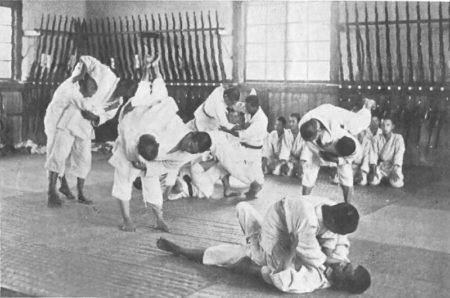تکان, حجم 1
I recently read تکان: داستان ناگفته جیو جیتسو در برزیل, حجم 1 توسط روبرتو پدریرا (لینک وابسته به آمازون), که داستان دیگری از آغاز BJJ را روایت می کند که ما در مصاحبه های مختلف با اعضای خانواده گریسی گفته ایم.. “تکان” ترجمه می کند “تکان دهنده” به پرتغالی برزیلی. در حالی که پدریرا به طور کامل به تحقیق و استناد به منابع اولیه می پردازد, بیشتر روزنامه های برزیلی, he draws conclusions to support a generally anti-Gracie narrative.
Pedreira does a good job explaining that what became Brazilian Jiu-Jitsu was originally Kodokan Judo. Mitsuya Maeda and the other Japanese teachers in Brazil were all black belts from the Kodokan. We also learn early on that a number of Brazilians became black belts under these teachers and were teaching “Jiu-Jitsu” before the Gracies. Pedreira points at that other Brazilians were the primary teachers of the Gracies.

Jujitsu Practice at a Japanese Agricultural School in 1922
Pedreira’s stiffest criticism is directed at Carlos Gracie. Pedreira portrays Carlos as a con man with strange ideas and a rudimentary understanding of grappling. Pedreira gives Helio some begrudging respect but believes his fighting record to be overblown and against mediocre competition.
I don’t agree with either assessment but Pedreira provides plenty of research to back up his assertions. I think readers will be shocked at some of the things the brothers did, when they were younger. <طول bbox_x = "543" bbox_y = "1494" bbox_w = "56" bbox_h = "20" fsize = "14" fweight = "3" قرمز = "255" سبز = "255" آبی = "255" آلفا = ", I don’t think you can deny either one’s impact on the martial arts.
Pedreira does introduce us to the other three Gracie brothers, however, who have been far too neglected. Pedreira has a generally favorable view towards Oswaldo (second oldest), Gastao, جونیور. (middle brother) and George, who was only two years older than Helio.
Oswaldo had a few professional fights himself but was primarily a teacher, who spread the family art outside of Rio de Janeiro. Gastao, جونیور. didn’t fight but was the best teacher of the brothers. He frequently taught the elite of Brazilian society and was responsible for the wealthy students attracted to the Gracie Academy. Gastao would later open an academy in Sao Paulo.
George was the first family champion, whose fought more extensively and for many more years than Helio. George was the other main instructor at the Gracie Academy but he and Carlos frequently disagreed. George refused to follow the diet created by Carlos. He also fought who ever challenged him and under any rule set. George’s Jiu-Jitsu was very aggressive, which would sometimes lead to losses. He also took part in prearranged fights.
سرانجام, “The Red Cat”, as George was known, would strike out on his own. Carlos and Helio would often announce that George was not representing the Gracie Academy in his fights. <طول bbox_x = "543" bbox_y = "1494" bbox_w = "56" bbox_h = "20" fsize = "14" fweight = "3" قرمز = "255" سبز = "255" آبی = "255" آلفا = ", they would train together for fights ocassionally. Eventually Carlos and George or Helio and George would have a disagreement, which would lead to another separation. Friction seemed to dominate the three men’s relationship.
I recommend تکان, حجم 1 to anyone interested in BJJ’s origins. <طول bbox_x = "543" bbox_y = "1494" bbox_w = "56" bbox_h = "20" fsize = "14" fweight = "3" قرمز = "255" سبز = "255" آبی = "255" آلفا = ", it can be rather dry at times, so be prepared for a slog through 778 pages of research. حجم 1 covers the years 1856 – 1949. I would also recommend you compare it to some of the history put out by the Valente Brothers. The true origin story of Brazilian Jiu-Jitsu is probably somewhere in the middle.
Clark Gracie recently said all BJJ schools should have a picture of both Carlos and Helio Gracie in their academies. It may be time to hang a picture of all five brothers in the academies.
You can leave a comment or ask a question about this or any post on my صفحه فیس بوک.
Pin It
